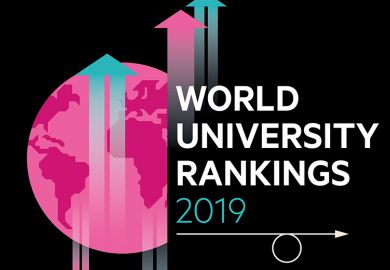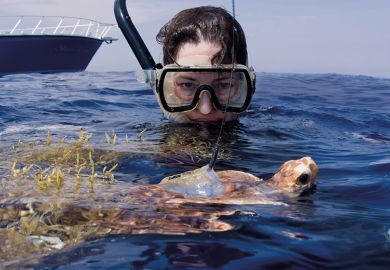Browse the full results of the World University Rankings 2019
The industry income pillar of the Times Higher Education World University Rankings offers an international collection of institutions, with 11 universities from Asia, Africa, Europe and North America tied for the top spot.
This pillar measures institutions’ amount of research income from industry per academic staff – a proxy for their knowledge transfer. For universities that score well in this pillar, businesses are interested in their research and form an important component of their income. However, the institutions push industry engagement for more than the money – it is a way to have a meaningful impact on society and train students in real-world settings.
Unlike most of the other pillars, these institutions’ good performance is highly dependent on their individual location and circumstances.
For the University of the Witwatersrand in South Africa – one of the universities tied for first place this year – industry income is an important way to make the institution sustainable. South Africa’s publicly funded universities, which are the country’s top-performing institutions, have been suffering owing to fiscal austerity, growing student numbers and insufficient income to fund all the demands on the public purse.
“Given the multiple obligations on the state, not all the resources for universities can come from the state,” says Adam Habib, vice-chancellor of Wits University. “In an environment of resource scarcity, [industry collaborators] bring in money that wouldn’t come from elsewhere. State funding is not enough.”
Search our database of more than 3,000 global university jobs
However, there is more to industry interaction than making up a funding shortfall, he says. “It focuses the mind on research that can have ripple effects across the economy, and it informs the very questions and the kind of research that we do.” These questions drive the country’s economy and help to develop new entrepreneurs.
Industry also offers a reservoir of talent, something that is important in a country such as South Africa that suffers from skills shortages. Collaboration allows university academics and industry experts to share knowledge, while students can interact with businesses and develop the real-world skills necessary to get a job, Habib says.
Habib intends to devote more time to industry engagement and meeting with chief executive officers and businesses to see how the university can address their needs. However, he is concerned that, as a university in a developing country, a large portion of Wits’ industry income is generated from international sources and therefore dependent on the global political climate. Going forward, he wants to diversify the university’s industry collaborators so that it is not dependent on funding from individual companies or countries.

A continent away, Gunther Neuhaus, the University of Freiburg’s vice-president for research, makes a point of meeting with businesses for “science days”, or, as Neuhaus jokingly calls them, “speed dating”. The university contacts and sets up meetings with companies, which choose the topics or areas of science to be discussed during the meeting. “It is a discussion group in which you discuss the future,” he says.
But he is very clear that it is not about securing industry contracts and that business does not dictate the university’s research agenda. “We are not getting a contract with industry, where industry decides what we do,” he says. “They are interested in what we are doing and, on science days, they say, ‘We want to invest in this, or that.’”
The University of Freiburg, also ranked joint first, is in a unique position in terms of its industry offering. The city of Freiburg is home to five Fraunhofer Institutes, which are government-established institutes that focus on applied research. These institutes exist in a symbiotic relationship with the university and industry, Neuhaus explains.
“We made an alliance with them, and Fraunhofer has fantastic contacts with industry,” he says.
Through collaborations with the Fraunhofer Institutes, the university’s basic research can be translated into industry, through research engagement and prototypes among other spin-offs.
The university engages not only with big industry players but also with small and medium enterprises and local chambers of industry.
However, entrepreneurship is a major focus of the university, with entrepreneurship information and support offered at all tiers, from undergraduates through to the professoriate. Neuhaus refers to this approach as “education, consulting and coaching”. “It pays back,” he says. “This is a strategy within the university regarding how we get more collaboration.”
But the university is also looking to – literally – cement a relationship between its researchers and industry. It has begun construction of an innovation centre on its campus: a 4,000 square-metre space, which it plans to offer to businesses to set up premises and to its own spin-off companies. It is expected to be complete in 2020.
Despite these developments, Neuhaus says that the goal of the university’s collaborations with industry is not to improve research.
“The [quality of the] science depends on the professors and postdocs we have, those we hire and the environment we offer them,” he says, adding that the collaboration with industry is important because it allows their research to have an impact in society. “We want to see our science working out in the public.”

Duke University in the US, another front-runner in the industry income pillar, has always made an active effort to engage with a number of industries, says Michael Schoenfeld, vice-president for public affairs and government relations.
“They are a source of new ideas, [they] create employment opportunities for students, [and] open up research and funding opportunities for faculty,” he says.
The university has a top-down infrastructure, through its central research and development offices, to develop these industry relationships, as well as a decentralised push through individuals in its different schools. “We also utilise our global alumni network to make connections,” Schoenfeld says.
The university has a wide range of industry interaction tools to facilitate engagement between research and business, from interdisciplinary research projects and internships through to conferences and global programmes.
Industry collaboration can “facilitate partnerships that can be helpful in stimulating innovation, entrepreneurship and community engagement”, Schoenfeld says. “[Duke’s] relationship with industry has been growing and evolving for many years, and we expect it to continue to expand.”
Industry pillar
|
Rank in pillar |
Position in World University Rankings |
Institution |
Country/region |
Pillar score |
|
=1 |
801–1,000 |
Turkey |
100.0 |
|
|
=1 |
18 |
United States |
100.0 |
|
|
=1 |
76 |
Germany |
100.0 |
|
|
=1 |
601–800 |
Turkey |
100.0 |
|
|
=1 |
301–350 |
United Arab Emirates |
100.0 |
|
|
=1 |
=32 |
Germany |
100.0 |
|
|
=1 |
351–400 |
Russian Federation |
100.0 |
|
|
=1 |
=44 |
Germany |
100.0 |
|
|
=1 |
=59 |
Wageningen University & Research |
Netherlands |
100.0 |
|
=1 |
201–250 |
South Africa |
100.0 |
|
|
=1 |
101 |
China |
100.0 |
|
|
=12 |
102 |
South Korea |
99.9 |
|
|
=12 |
48 |
Belgium |
99.9 |
|
|
=12 |
251–300 |
Moscow Institute of Physics and Technology |
Russian Federation |
99.9 |
|
15 |
22 |
China |
99.8 |
|
|
16 |
501–600 |
Taiwan |
99.7 |
|
|
=17 |
58 |
Netherlands |
99.6 |
|
|
=17 |
=167 |
Netherlands |
99.6 |
|
|
19 |
103 |
Switzerland |
99.4 |
|
|
20 |
501–600 |
China |
99.2 |
|
|
21 |
=87 |
Germany |
98.8 |
|
|
22 |
801–1,000 |
China |
98.5 |
|
|
=23 |
401–500 |
China |
98.4 |
|
|
=23 |
401–500 |
China |
98.4 |
|
|
=25 |
=135 |
Germany |
98.3 |
|
|
=25 |
198 |
South Korea |
98.3 |
|
|
=27 |
501–600 |
India |
98.2 |
|
|
=27 |
301–350 |
Belgium |
98.2 |
|
|
=27 |
601–800 |
Pontifical Catholic University of Rio de Janeiro (PUC-Rio) |
Brazil |
98.2 |
|
30 |
201–250 |
South Korea |
97.2 |
|
|
31 |
=82 |
South Korea |
96.9 |
|
|
32 |
601–800 |
China |
96.7 |
|
|
33 |
1,001+ |
Turkey |
96.5 |
|
|
34 |
501–600 |
Taiwan |
96.4 |
|
|
35 |
30 |
United States |
96.0 |
|
|
36 |
251–300 |
Sweden |
95.7 |
|
|
37 |
65 |
Japan |
95.6 |
|
|
=38 |
=12 |
United States |
95.5 |
|
|
=38 |
351–400 |
Turkey |
95.5 |
|
|
40 |
501–600 |
China |
95.2 |
|
|
=41 |
501–600 |
China |
94.5 |
|
|
=41 |
151 |
Germany |
94.5 |
|
|
43 |
142 |
South Korea |
94.3 |
|
|
44 |
131 |
Germany |
94.2 |
|
|
45 |
601–800 |
Iran |
93.8 |
|
|
46 |
77 |
Canada |
93.5 |
|
|
47 |
501–600 |
Saudi Arabia |
93.3 |
|
|
48 |
601–800 |
China |
92.7 |
|
|
49 |
=135 |
Germany |
92.5 |
|
|
50 |
801–1,000 |
Bandung Institute of Technology (ITB) |
Indonesia |
92.4 |
POSTSCRIPT:
Print headline: Symbiotic alliances
Register to continue
Why register?
- Registration is free and only takes a moment
- Once registered, you can read 3 articles a month
- Sign up for our newsletter
Subscribe
Or subscribe for unlimited access to:
- Unlimited access to news, views, insights & reviews
- Digital editions
- Digital access to THE’s university and college rankings analysis
Already registered or a current subscriber?








